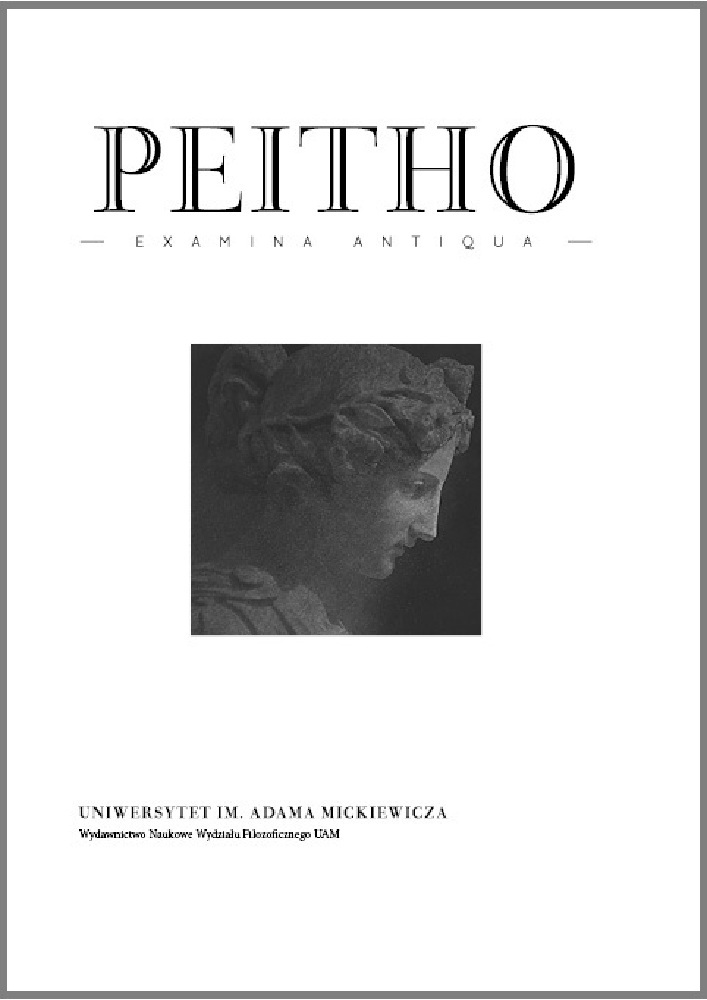Abstract
As Plato’s Phaedrus 246c stipulates, every logos must be structured like a living being, i.e., the relation of all its parts to one another and to the whole must be appropriate. Thus, the present paper argues that Plato’s masterwork has been organized in accord with the ascent/descent movement as presented in the Allegory of the Cave: Book I represents eikasia, Books II–IV.434c exemplify pistis, Book IV.434d–444e illustrates dianoia and Books V–VII express noesis. Having reached the anabasis (with the Sun, the Line and the Cave images) the philosopher turns to the consideration of the deficient or unjust forms of the souls and the corresponding political regimes. Finally, the discussion comes back to eikasia through the renewed criticism of mimesis and the exposition of the Myth of Er. As is typical of Plato, this is not merely a formal matter, since the structure conveys that as the Good makes the Ideas intelligible, so the Sun, the Line and the Cave images also throw light on the whole dialogue.
References
Adam, J., 1963, The Republic of Plato, vol. I–II, Cambridge.
Benson, H. H., 2008, “Knowledge, Virtue and Method in Republic 471c–502c”, Philosophical Inquiry 30, S. 87–114.
Blössner, N., 1997, Dialog form und Argument. Studien zu Platons Politeia, Stuttgart.
Burnyeat, M., 2005, „ΕΙΚΩΣ ΜΥΘΟΣ”, Rhizai 2, S. 143–165.
Dominick, Y. H., 2010, “Seeing Through Images: The Bottom of Plato’s Divided Line”, Journal of the History of Philosophy 48, S. 1–13.
Ferguson, A. S., 1921, “Plato’s Simile of Light Part I”, The Classical Quarterly 15, S. 131–152.
Dorter, K., 2004, “The Divided Line and the Structure of Plato’s Republic”, History of Philosophy Quarterly 21, S. 1–20.
Gutiérrez, R., 2002, “La Lógica de la Decadencia. En torno a las formas deficientes de gobierno en la República de Platón”, Estudios de Filosofía 26, S. 43–60.
Gutiérrez, R., 2003, “The Logic of Decadence”: On the Deficient Forms of Government in Plato´s Republic”, The New Yearbook for Phenomenology and Phenomenological Philosophy 3, S. 85–102.
Gutiérrez, R., 2003a, “En torno a la estructura de la República de Platón”, Apuntes Filosóficos 22, S. 81–94.
Gutiérrez, R., 2003b, “La estructura de los símiles de la República como clave hermenéutica: el Parménides y otros” in: R. Gutiérez (ed.), Los símiles de la República VI–VII de Platón, Lima.
Gutiérrez, R., 2009, “Dialéctica, Koinonía y Unidad. República V y las hipótesis II y III del Parménides”, in: M. Perine (org.), Estudos Platônicos, São Paulo, S. 113–135.
Gutiérrez, R., 2011, “Die Stufen der Selbsterkenntnis in Platons Politeia“, in: U. Bruchmüller (hrsg.), Herme¬neutik und Prinzipiendenken: von Platon über Aristoteles zu Plotin, Hildesheim 2011, S. 329–344.
Gutiérrez, R., 2013, “Disputas sobre las sombras de la εἰκασία y las estatuas de la πίστις”, in: R. Gutiérrez, Μαθήματα. Ecos de Filosofía Antigua, Lima, S. 231–251 (auch in: R. Radice, G. Tiengo (cur.), Seconda Navigazione. Omaggio a Giovanni Reale, Milano 2015, S. 293–310).
Gutiérrez, R., 2016, “The Three Waves of Dialetic in Republic”, in: G. Cornelli (ed.), Plato´s Styles and Charac¬ters, Berlin–New York, S. 15–32.
Gutiérrez, R., 2017, El Arte de la Conversión. Un estudio sobre la República de Platón, Lima.
Gutiérrez, R., 2018, “Aspects of the Dianoetical Consideration of the Soul in the Republic”, in: Platonic Inves¬tigations 9. 2, S. 1-19.
Jackson H., 1882, “On Plato’s Republic VI, 509 sqq.”, in: Journal of Philology 10, S. 132-150
Karasmanis, V., 1988, “Plato’s Republic. The Line and the Cave”, Apeiron 21, S. 147–171.
Krämer, H.-J., 1959, Areté bei Platon und Aristoteles, Heidelberg.
Ludlam, I., 2015, Plato’s Republic as a Philosophical Drama on Doing Well, Lanham–Boulder–New York–London.
Schleiermacher, F., 1991, Platon, Politeia, Frankfurt am Main–Leipzig.
Robinson, R., (19532), Plato’s Earlier Dialectic, Oxford.
Ross, D., 1986, Teoría de las Ideas de Platón, trad. J.L. Díez Arias, Madrid.
Rufener, R., 2000, Plato, Der Staat. Politeia, Düsseldorf–Zürich.
Santa Cruz, M. I., 1997, “Le discours de la Physique: eikòs lógos”, in: T. Calvo, L. Brisson (eds.), Interpreting the Timaeus-Critias. Proceedings of the IV Symposium Platonicum, Sankt Augustin, S. 133–139.
Smith, N., 1999, “How the Prisoners in the Cave are «Like Us»”, Proceedings of the Boston Area Colloquiumin Ancient Philosophy 13, S. 187–204.
Szlezák, T. A., 1985, Platon und die Schriftlichkeit der Philosophie, Berlin–New York.
Szlezák, T. A., 1997, „Das Höhlengleichnis“, in: O. Höfe (hrsg.), Platon. Politeia, Berlin, S. 205–228.
Wilson, J. R. S., 1995, “Thrasymachus and the Thumos: A Further Case of Prolepsis in Republic I”, The Classical Quarterly 45, S. 58–67.
License
Peitho provides immediate open access to its content on the principle that making research freely available to the public supports a greater global exchange of knowledge.
